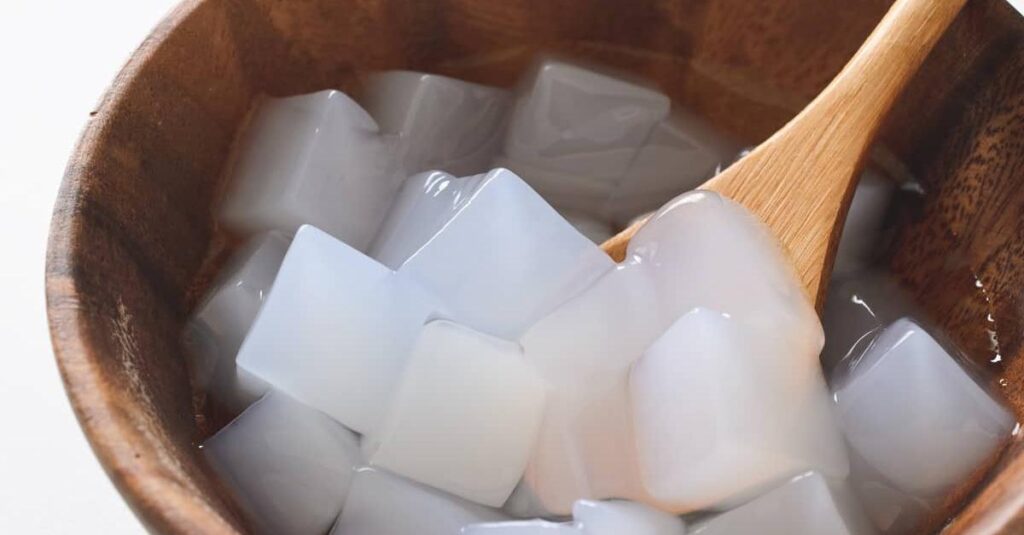Are you curious to know what is nata de coco? You have come to the right place as I am going to tell you everything about nata de coco in a very simple explanation. Without further discussion let’s begin to know what is nata de coco?
As the culinary world continues to explore diverse flavors and textures, one delightful ingredient that has gained popularity in both Asian and global cuisine is “Nata de Coco.” This sweet and chewy treat, often used in desserts and beverages, has become a favorite among those with a penchant for unique and delightful culinary experiences. In this blog post, we will dive into the world of Nata de Coco, exploring its origins, production process, and its versatile use in a wide array of dishes.
What Is Nata De Coco?
Nata de Coco, often referred to as “Nata,” is a translucent, jelly-like substance made from fermented coconut water. It originates from the Philippines and is a beloved ingredient in various Southeast Asian desserts and beverages. The term “Nata de Coco” is Spanish for “cream of coconut,” reflecting the Spanish influence in the Philippines during colonial times.
Key Characteristics Of Nata De Coco:
- Texture: Nata de Coco has a unique chewy and gelatinous texture. It is often described as having a consistency similar to that of gummy candies or fruit jelly.
- Flavor: Nata de Coco is mildly sweet with a subtle coconut flavor. Its mild taste makes it a versatile ingredient that can be paired with a variety of flavors.
- Translucence: When properly prepared, Nata de Coco is translucent, allowing it to absorb the flavors of the liquids or syrups it is soaked in.
- Color: Nata de Coco is typically white or cream-colored, but it can be tinted with food coloring to add visual appeal to desserts.
The Production Process:
The production of Nata de Coco involves a fermentation process, which is a fascinating blend of science and culinary art. Here are the key steps:
- Extraction of Coconut Water: The process begins with the extraction of fresh coconut water from young green coconuts. This water serves as the primary ingredient for Nata de Coco.
- Fermentation: The coconut water is mixed with a bacterial culture, typically Acetobacter xylinum. This culture consumes the sugars in the coconut water and produces cellulose fibers, forming a gel-like substance.
- Growth and Harvest: The mixture is left to ferment for several days to allow the culture to grow and create the desired jelly-like texture. Once the fermentation is complete, the Nata de Coco is harvested and cut into cubes or other desired shapes.
- Flavoring and Packaging: After harvesting, Nata de Coco is often soaked in flavored syrups or fruit juices to impart taste. It is then packaged for distribution to be used in various culinary applications.
Versatile Culinary Uses:
Nata de Coco is a versatile ingredient that can be used in a variety of dishes and beverages, including:
- Desserts: It is commonly used in desserts like fruit salads, ice cream, and bubble teas, adding a delightful chewy texture and sweetness.
- Cocktails and Beverages: Nata de Coco makes a refreshing addition to cocktails, fruit punches, and smoothies, enhancing both flavor and texture.
- Snacks: Some enjoy Nata de Coco as a standalone snack due to its mild sweetness and chewy texture.
- Toppings: It can be used as a topping for yogurt, puddings, and cakes, providing an interesting contrast in texture.
Conclusion
Nata de Coco is a delightful culinary creation that has captured the hearts and taste buds of people around the world. Its unique texture and mild coconut flavor make it a versatile ingredient for a wide range of dishes and beverages. Whether you encounter it in a fruity dessert, a tropical cocktail, or a refreshing bubble tea, Nata de Coco adds a special touch to culinary experiences and offers a sweet and chewy delight that continues to be celebrated in global cuisine.
You can search for more information on Snorable.
FAQ
What Is Nata De Coco Made Of?
Nata de coco is a unique Filipino specialty that is made with fermented coconut water. After days of fermentation, it transforms into a jelly-like substance with a soft, chewy, and gelatinous texture.
Is Nata De Coco Healthy?
Nata de coco is low in calories and contains vitamins (vitamins B, B1, B2, C) which will assist to boost immunity of children. Additionally, Nata de coco, by itself, is suitable for diabetes patients’ consumption in moderation. Let’s try including Nata de coco to your dessert or into to your kids’ diet!
What Is Nata De Coco Side Effects?
Side Effects of Nata de Coco Juice:
- High sugar content: Nata de coco juice may contain added sugars, which can contribute to weight gain and other health problems if consumed in excess.
- May cause digestive issues: Nata de coco is high in fiber, which can cause digestive discomfort if consumed in large amounts.
What Is The English Term Of Nata De Coco?
Spanish nata de coco (literally “coconut cream”).
I Have Covered All The Following Queries And Topics In The Above Article
What Is Nata De Coco
What Is Nata De Coco In English
What Is Nata De Coco Made Of
What Is Coco De Nata
What Is Nata De Coco Made From
Nata De Coco What Is It
What Is Nata De Coco Made Out Of
What Is Jubes Nata De Coco
What Is Nata De Coco Jelly
What Is Nata De Coco
What is nata de coco?
Can diabetics eat nata de coco?






